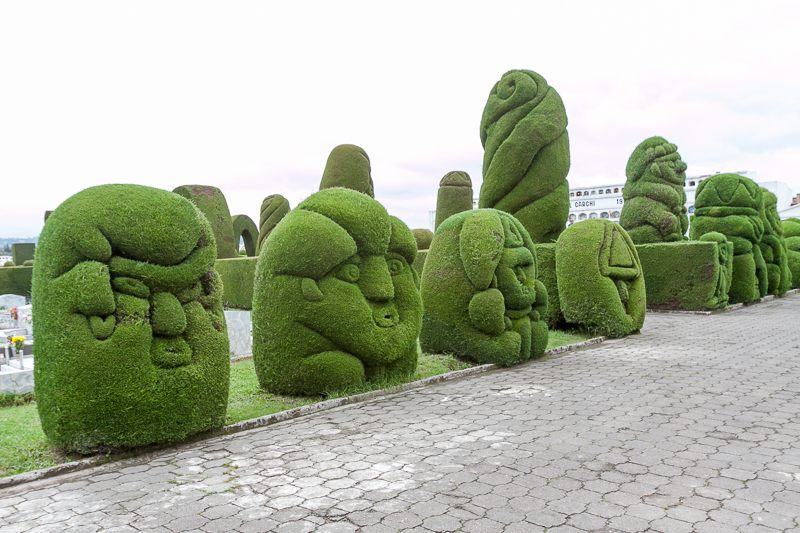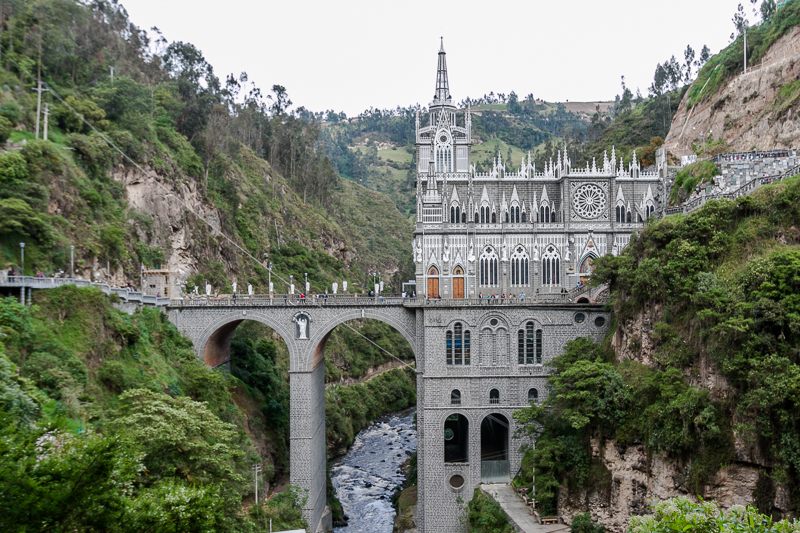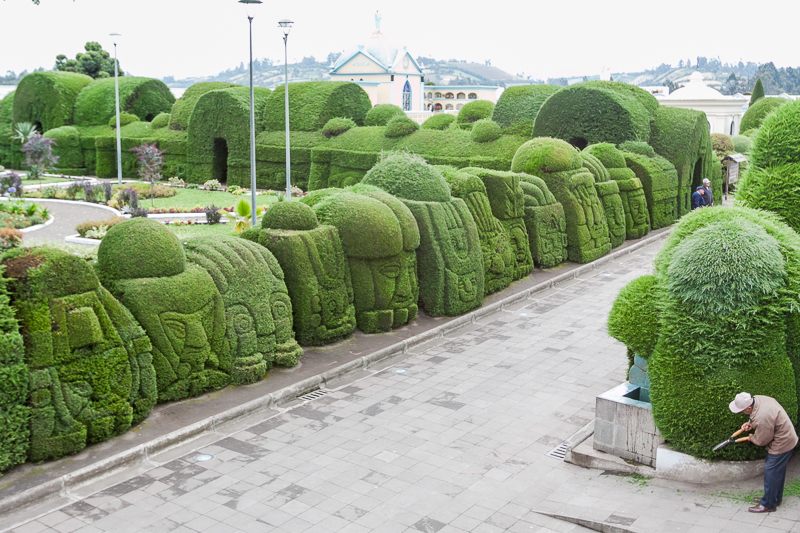Is This the World’s Most Interesting Border Crossing?
 There are more than 100 enormous topiary sculptures in the Municipal Cemetery in Tulcán, Ecuador, five miles from the border with Colombia. (All photos: Eric Mohl)
There are more than 100 enormous topiary sculptures in the Municipal Cemetery in Tulcán, Ecuador, five miles from the border with Colombia. (All photos: Eric Mohl)
Across the Americas, border towns can be sketchy, Wild West-like places with an aura of desolation. Usually, the only reason to stop is to endure the draconian and dismal passport stamping procedures required to travel from one country to another. However, the border between Ipiales, Colombia and Tulcán, Ecuador features the most improbable church in Colombia and the most high maintenance cemetery in Ecuador.
On the Colombian side, less than ten miles from the border with Ecuador, the Las Lajas Sanctuary dominates a narrow, deep gorge with its stony bulk. The Gothic revival style church, built between 1916 and 1949, rises 330 feet from the bottom of the canyon. The Guáitara River rages below the structure, which is accessed via a 160-foot-long stone foot bridge.
The incredibly ornate Roman Catholic cathedral, called the Sanctuary Las Lajas after the Spanish word for the shale-like stone in the area, has humble roots. In 1754, a local indigenous woman named Maria Mueces and her deaf-mute daughter, Rosa, were walking through the gorge when Rosa meandered into a small cave and suddenly spoke, saying she’d seen a woman carrying a baby. This was eventually interpreted as a sighting of the Virgin Mary and the deaf-mute woman’s sudden ability to speak was considered a miracle. The devout also believe that Rosa had many interactions with the Virgin Mary, and was even brought back to life by her.
 Las Lajas Sanctuary, built into a gorge near the border between Colombia and Ecuador, is said to be the site of a Virgin Mary miracle.
Las Lajas Sanctuary, built into a gorge near the border between Colombia and Ecuador, is said to be the site of a Virgin Mary miracle.
People began making pilgrimages to the cave, which now featured an image of the Virgin Mary that “miraculously” appeared on one wall, to ask the Virgin for their own miracles. By 1802 a simple shrine had been built over the site, and this was expanded and improved year after year until it finally reached its current grandeur, from simple stone slab to stone masterpiece.
A museum inside the sanctuary has exhibits which recount the story of the miracle and photos that show the evolution of the cathedral. The original laja from the cave,bearing the image of the Virgin Mary, is now part of the altar. The grounds around the sanctuary include paths through the gorge, a few basic eateries and a waterfall. Visitors picnic and take pictures in an atmosphere that is part church and part park.
Thousands of pilgrims come to the Sanctuary Las Lajas every September to mark the date of Rosa’s recovery, which is said to have taken place on September 16. Many of them sleep at the Casa Pastoral, which is run by nuns living on the rim of the canyon. At around $9 for a double room, it’s a basic guest house with hard, lumpy beds and cold water bathrooms, but magnificent views of the striking Gothic cathedral inspired by a religious apparition from 261 years ago.
Four miles from the border with Colombia and 12 miles from the church, the town of Tulcán, Ecuador, holds two distinctions: it’s the highest city in Ecuador at 9,680 feet above sea level, and it’s home to one of only a handful of topiary cemeteries in the world. For the latter, you can thank local gardener Josè Maria Azael Franco.
 A team of gardeners, including sons of the creator of the topiary garden in the Municipal Cemetery in Tulcán, work full time to maintain this unique cemetery.
A team of gardeners, including sons of the creator of the topiary garden in the Municipal Cemetery in Tulcán, work full time to maintain this unique cemetery.
In the 1930s, Mr. Franco began sculpting the cypress bushes that grew in the cemetery where he worked, shaping the plants, which can live for 500 years and grow more than 100 feet tall, while wearing slacks and a jacket. He never stopped, and eventually every cypress had been transformed until the cemetery was, in Mr. Franco’s own words, “so beautiful it invites one to die.” The Municipal Cemetery of Tulcán now has more than 100 enormous, intricate creations covering the three-acre site.
You might expect somber religious themes in a cemetery topiary garden, but from day one the designs here were meant to celebrate Ecuadorian flora, fauna and indigenous cultures, including animals from the Galapagos Islands. Mr. Franco also found inspiration in Roman, Incan, Aztec and Egyptian themes as well. Long walkway tunnels connect different areas of the cemetery, creating tall chambers that feel private and unexpected. Dr. Edgar Anderson, a past director of the Missouri Botanical Garden, called the topiary here “the most elaborate in the world,”and Mr. Franco’s vision and hard work give the cemetery a lush, uplifting feel. Locals visiting long-lost loved ones in the cemetery are happy to point visiting tourists to the best vantage points for photos of Mr. Franco’s handiwork.
Mr. Franco passed away in 1985, two years before Ecuador’s Ministry of Tourism named his creation a “natural tourism site of interest.” Of course, Mr. Franco is buried in the cemetery he helped create, and a team of full-time gardeners, including some of his sons, continues to maintain and expand the topiary.











Follow us on Twitter to get the latest on the world's hidden wonders.
Like us on Facebook to get the latest on the world's hidden wonders.
Follow us on Twitter Like us on Facebook